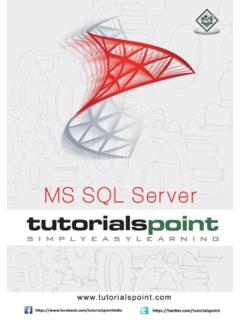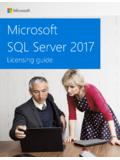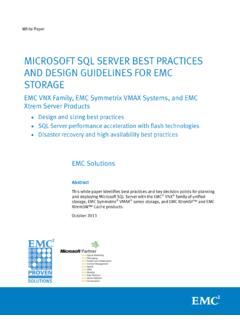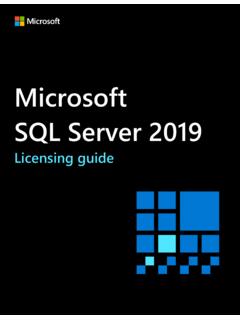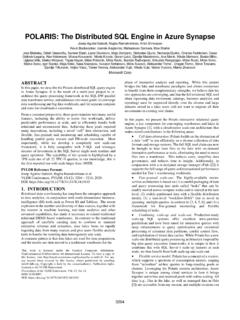Transcription of Introduction to SQL Server Database Administration
1 Introduction to SQL Server Database AdministrationTribal Data WorkshopApril 10 11, 2018 CRITFCP ortland, OregonAgenda Exactly what is a DBMS? Security Management Introducing SQL Server Manager System (SSMS) Administrative TasksoAdding a new useroChanging a passwordoRe-enabling a locked out accountoGranting/Denying Access to a DBoGranting/Denying Access to a TableoCreating a New DatabaseoDeleting a DatabaseoCreating a TableoQuick Tutorial on Data TypesoDeleting a TableoSetting the Primary KeyoBacking Up the DatabaseoRestoring a Full BackupoDatabase Indexes TutorialoData EncryptionBuckle Your SeatbeltWe have a lot to cover in a relatively short timeframe Relational databases form the bedrock of western civilization - Bruce Lindsay, IBM ResearchStanford University: CS145 materialsA Little VocabularySchema.
2 Anunderlyingorganizationalpatternorstruc ture;conceptual framework In a Database , a schema is a description of a particular collection of data, using the given data model For SQL Server , the data model is the relational modelWhat Makes Up A Relational Database (RDB)?An RDB: Is a collection of data tables Some tables model entities Some tables model relationships They capture a relationalmodel of the problem domainCustomerSavingsAccountownsEntities RelationshipLogical Domain ModelCNumSNum123 991561 1033 497 567 SNumAmount991 John Smith561 Jo Williams497 Sally SmithCustomerOwnsSavings AccountRelational Domain Modelprimary keyprimary keyforeign keyforeign keyequivalent modelsWhat is a Database Management System?
3 A Database Management System (DBMS) like SQL Server is a piece of software designed to store and manage multiple RDBsSQL ServerBank DBSchool DBBusiness DBHospital DBContains and managesDBsAnd other related objectsBI Analytics ToolReporting ToolApplicationProvides services to integrated DB tools and other applications which process DB dataWhat exactly does a DBMS manage? Basic responsibilities of a DBMS: Processes queries to provide structure access to data in DBs Enforces secured access to tables and other DB objects Provides the ability to create stored procedures, functions, and triggers Creates and maintains indices on columns Backs up and recovers the DBs Imports and exports data Creates and maintains DBs, schemas, indices, and other metadata Logs event information And much moreSome of the Much More Tools for performance analysis, tuning, report generation, and trouble shooting The ability deploy high availability configurations of the DBs The ability to do data mirroring Integration with reporting , BI.
4 And analytic tools Integration of R procedures into DB stored procedures The ability to cluster multiple DBMSs Andstill more depending on the version and brand of the DBMSS ince this is a basic course in SQL Server , these topics are not covered. Security Management: User, Groups, and Rights Access to data in table/columns is controlled by the security model The model is based on three kinds of entities: Users / Logins Rights / Privileges Groups/Roles The diagram below lays out the three entities used to manage and enforce DB security:Group/Role: A collection of users Can have rights associated with it that users inherit with membershipUser/Login: Account assigned to an individual* A user can belong of one or more groups Can have rights specifically granted directly to themRight/Privilege: Grant or deny the ability to affect a Database object (table, column, index, etc.)
5 The four basic rights are listed below plus no rights : Read Write Delete Execute (does not apply to data entities)*exception to this rule, account assigned to an applicationThe SA There is a single user account SA (system administrator) which is all powerful in the DBMS The SA: effectively owns the DBMS has allrights to control allentities in DBMS and is therefore a very dangerous account (more later)Access Security ExampleCNumName123 John Smith561 Jo Williams497 Sally SmithCustomerA DB table:JimMaggieTo mBelongs tohas no rights assigned to himFinance DeptGrouphas read and write rights for Customerhas read and write rights for Customerhas the read right for Customerhas no explicit right assigned to him for the tableSAPop QuizWho can write to the table?
6 Who can delete the table?Who could query data for a report? Some Best Practices for Security Beware the SA account! This account can overwrite or delete anythingin the DBMS this includes metadata the DBMS must have to function correctly We re all human and can make mistakes, mistakes by the SA can destroy the DBMS So, DON Tlog into the SA account unless you must be in it to get a task done And, once you finish the task(s), log out immediately! Grant users as few rights as possible --this is preventative medicine to avoid mistakes Groups are a good way to assign rights Groups often map well to organization units ( , departments, project teams) People in the same group often need exactly or mostly the same rights If a group needs to have its rights adjusted you only have to adjust the group not all the users individually great time saverSQL Server Management Studio (SSMS) Consoletool barconnection barserverserver contentsobjectpropertiesobject being displayedSSMS comes with SQL ServerDon t Panic!
7 Since this is a beginning course, we are only going to concentrate on: Databases Security For basic applications, these are the only two areas you need to do work in Others areas could be part of a more advanced course -- maybe next yearAdding a New User (Login)Dropdown Security and Right click on Logins>New Login from the dropdown menu that appearsSally1. Click on General to get this form2. Type name for new Login3a. Choose login type3b. If you choose SQL login, these fields become typeable and you are required to fill them inIgnore these fields4. Click this when you are done entering dataIgnore these fieldsfor nowChanging a Password1. Drop down Security->Logins and double click on the account needing to be reset2.
8 When window opens, type in new password and the confirmation3. Then click OK and window closesRe-enabling a Locked Out User Account1. Drop down Security->Logins and double click on the account needing to be reset2. Click on Status 3. Click on Enabled 4. Click on Okay You can also dis/enable an account on this pageGranting/Denying Access to a DB1. Drop down Security->Logins and double click on the account needing to be reset2. Click on User Mapping 3. Check the box by the DB you want to give access rights to4. Check the boxes by the types of access you want to grant (or uncheck to remove right)5. Click OK to adjust the rightsGranting/Denying Access to a Specific Table1. Drop down Tables, click on table name, right click and select Properties2.
9 Click on Permissions3. Click on searchGranting/Denying Access to a Specific Table (cont)4. Click on browse5. Check the box next to user you want to adjust table permissions for6. Click OK Granting/Denying Access to a Specific Table (cont)8. Click OK 9. Adjust permissions with check boxes and click OK SQL: Grant and Deny Security objects can have their characteristics modified directly by using T-SQL See commands: GRANT DENY CREATE ROLE ALTER ROLE DELETE ROLE Examples can be found in the documentation This allows you to write scripts or functions to carry out security adjustments See T-SQL reference at: a New Database1. Click on Databases >New DatabaseIgnore these two options2. Type name for new database3.
10 This can remain <default> 4. Just leave these at default values for now5. Click on OK and Database will be created (don t click on Add)This creates a DB that is essentially an empty container. Columns added in a separate operationNote: you can only create a Database if you have been given the right to do soDeleting a Database1. Right click on the Database you want to delete2. Select Delete from the dropdown menuNote: you can only delete a Database if you have been given the right to do soCreating a Table1. Dropdown the Customer, click on Tables>NewTable editor opens in workspace. Creating a Table (cont)1. On toolbar, click on View>Properties Window2. On right edge of screen, the Properties window displays and shows properties of new tableCreating a Table (cont)1.


